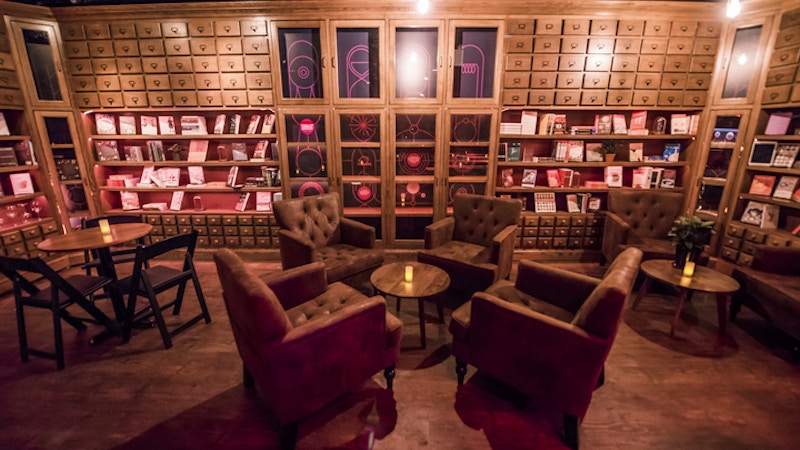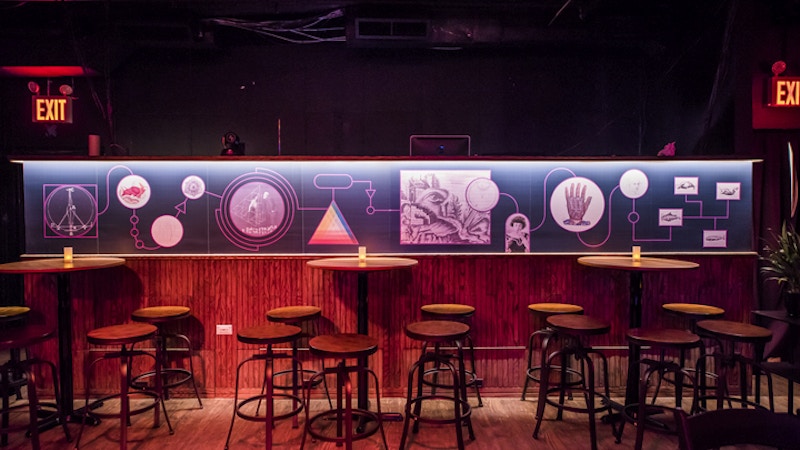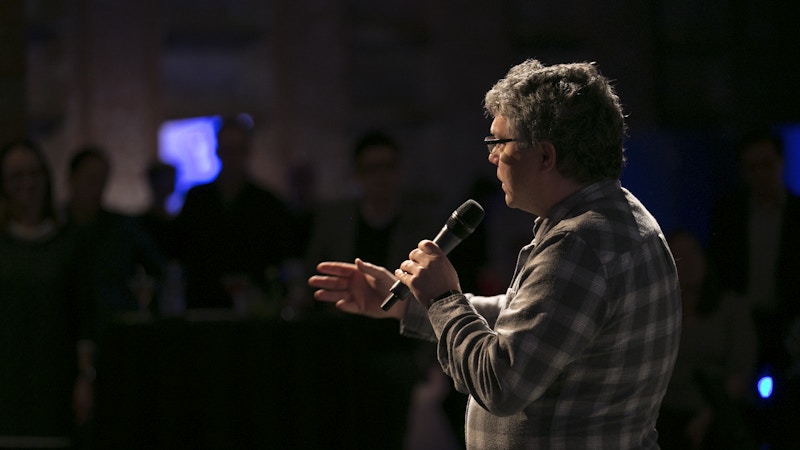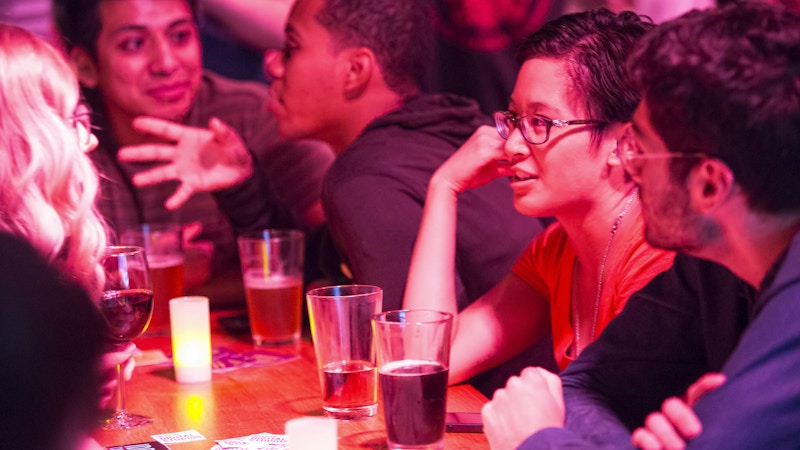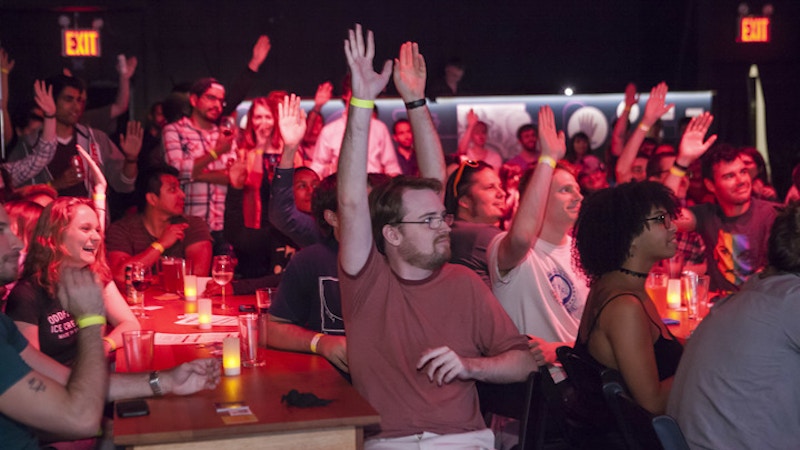
Ben Lillie: Fostering ‘Intelligent Nightlife’
Vintage armchairs add to the speak-easy feeling at Caveat. (credit: Caveat)
For the first few months of its existence, Caveat, a new event space on the Lower East Side of Manhattan, didn’t have a marker to indicate an entrance. “Yeah, we’re fixing that,” Ben Lillie, the venue’s founder, explained in December. “We’re spray-painting our logo on the door tomorrow, actually.”
Still, one could be forgiven for walking past the place. The lack of signage was intentional, according to Lillie — an effort to create a specific ambience. “This was going to be a literal speak-easy. But then I realized there was no way we would ever get a full liquor license.”
But the speak-easy feeling remains. After descending the stairs into the Clinton Street basement, visitors walk down a long, mostly white hallway until they reach dramatic satin curtains. The curtains reveal a sprawling, dimly lit room filled with wood-paneled walls, well-stocked bookshelves, cabaret tables and vintage armchairs.
The guests inside chat over cocktails, most likely waiting for the show to start — depending on the night, it might be “What Is Life,” a series hosted by science writer Carl Zimmer that aims to tackle the massive question from the perspective of philosophy, physics or chemistry. Or maybe it’s a performance by North Coast, a New York-based group that performs improvised historical hip-hop musicals based on a suggestion from the audience. Whatever the show, as Lillie sees it, it’s probably not quite like anything the audience has seen before.
It’s all part of an effort to create a new mode of nighttime entertainment — something Lillie refers to as ‘intelligent nightlife,’ a way to go see a show without choosing between learning something and having fun.
In the edited transcript below, Lillie discusses his motivations for opening Caveat and how he and his staff are working to deliver academic performance art in the middle of one of New York’s biggest party neighborhoods.
You’ve been in the events world for a while now, having previously worked with the Story Collider. What led to the decision to open Caveat?
I left science and came into the performance world because I wanted to do something humanistic with science. I ended up discovering Moth-style storytelling, which led to my founding the Story Collider. I also worked for TED for a while and I learned a lot about high-production-quality things there. But TED is a singular editorial voice, and it uses a single format. I wanted to find a place that would allow me to experiment and produce things in other formats that are TED-like and reach a mass audience, so I opened this space to create content that blends academics with performing arts.
You’ve used the phrase ‘intelligent nightlife’ to describe Caveat. What do you mean by that?
We tried out various descriptions of what we’re doing. And ‘intelligent nightlife’ was an ad-lib one night, but people seemed to understand what that means. So we thought, “OK, we’re getting closer to some descriptor of what we’re doing.” What’s important to us is that it feel fun to come out here, and not feel broccoli-like.
Broccoli-like?
Broccoli-like. Like, you eat broccoli because you’re supposed to. You go to an intelligent talk because you’re supposed to. We want to create a place where you say, “Oh, this is fun. There is serious discussion of things going on here, and it’s a party.” This is as much about reinventing the culture of nightlife as it is about academics. Going out and having fun doesn’t have to be empty. There can be serious substance to it.
But when discussing the Story Collider, you’ve made it a point not to use the word ‘informative.’
Yup, the first rule of Story Collider is ‘no learning.’ [Laughs.]
So is Caveat a departure from that approach?
No, it’s an evolution. I make a big deal about the no-learning thing in Story Collider because the audience is primarily scientists. And one of the things we try to do there is to show scientists the power of art forms — in particular, the narrative art form. So we say that ‘no learning’ line to establish that this is a night out of fun, and on this night of fun something extraordinary is happening that maybe is informative.
At Caveat, Carl Zimmer’s event [“What Is Life”] is the most formal learning we get. But the notion that there’s some sort of dichotomy is what we’ve been working to break down.
How do scientists view your efforts?
I was at this conference recently talking about a show we just booked called “Drunk Education,” where a bunch of experts get drunk, get onstage and give a talk about something they care about. And one of the most successful ones was an evening about Carly Rae Jepsen.
So at this conference of scientists and artists, you could feel the skepticism — I’m like, “Look, if you don’t want to take people seriously with the things they like, you’re sort of missing an entire way of interacting with society.”
This is all part of the same culture. We just sort of artificially demarcate it so that we aren’t letting these things come into contact with each other. And if you really are serious about reaching out to other cultures and other subcultures, you need to be very serious about the things they like and the things they participate in.
What are some venues — not necessarily traditional science venues — that inspired you when you were developing Caveat?
The vibe and a lot of the architecture was modeled after Le Poisson Rouge, as well as Oberon in Cambridge, Massachusetts. We took a lot of inspiration from Union Hall and the Bell House in Brooklyn. And we learned a lot about how to rig recording equipment at the Greene Space.
And what about the audience — are you targeting a specific demographic?
Part of our demographic comes from the neighborhood itself: We are located on the Lower East Side, adjacent to what’s called ‘Hell Square.’ The reason we do an event called “Pregame Your Brain” on Friday nights is so that people can come to this intellectual thing and then go out and do other stuff on the Lower East Side.
We have hosted shows that fill the room with people under 30. And we have ones with a pretty broad range, from people in their 60s or 70s to people in their 20s. Beyond that, we don’t know much in detail about our audience. We’re still pretty new. One thing we know for sure is — it is definitely not the case that the same audience is coming for every show.
Can you talk a bit about the idea of bringing theatricality to a science talk, whether though the “Talks Progress Administration” or through other Caveat programming?
I started asking this question: “Why aren’t people going to a science talk? What’s getting in the way?” And as soon as you start thinking of it that way, the answer’s really unfortunately very clear. Most science talks are boring.
This is a craft. It takes a lot of time to develop the craft. And if you are a person onstage talking about science to an audience, what you are doing is stagecraft. And you might not think it’s that, but it plays by the same rules that all stagecraft everywhere plays by. And if you aren’t aware of those rules, you’re probably doing it badly.
So what do you do about that? The most direct thing I could think of was to pair speakers with a stage director who knows what they’re doing. It is literally the director’s job to think about the audience experience. So they can work with the scientist or other academic doing these presentations and say, “OK. Here’s what the audience is feeling right now. What do you want them to be feeling? Here are the kinds of things we need to do to get there.”
Caveat joined the Science Sandbox community of awardees in July 2017. For more information about Caveat and its programs, visit caveat.nyc.
_____
Stories of Impact highlight the real-world influences of Science Sandbox projects through personal narratives, videos and interviews. Discover more stories here.
